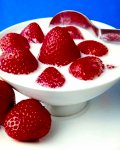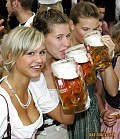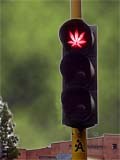 I discovered a rather intriguing perspective on the world of wellbeing, health and nutrition in the latest issue of the journal World Review of Science, Technology and Sustainable Development (2008, 5, 104-123). In it, Sundus Tewfik of the Department of Health and Human Sciences at London Metropolitan University and Ihab Tewfik of the University of Westminster, shed light on nutraceuticals, or functional foods as they are sometimes called. You will doubtless have seen mention of functional foods and botanical dietary supplements as they seem to fill the advertising space in Sunday supplements and feature regularly in lifestyle magazines.
I discovered a rather intriguing perspective on the world of wellbeing, health and nutrition in the latest issue of the journal World Review of Science, Technology and Sustainable Development (2008, 5, 104-123). In it, Sundus Tewfik of the Department of Health and Human Sciences at London Metropolitan University and Ihab Tewfik of the University of Westminster, shed light on nutraceuticals, or functional foods as they are sometimes called. You will doubtless have seen mention of functional foods and botanical dietary supplements as they seem to fill the advertising space in Sunday supplements and feature regularly in lifestyle magazines.
Apparently, nutraceuticals promote wellbeing and underpin public health by providing a supposedly natural way to lower raised cholesterol levels, help unblock clogged arteries, ward off otherwise inevitable cancers, and ease the machinations of the over-sensitive gut. All this, without anyone having to resort to pharmaceutical products and double-blind placebo-controlled clinical trials.
It’s the opening paragraphs of the paper that were the most interesting with regard to the state of play when it comes to the gradual public acceptance of the marketing hype surrounding nutraceuticals:
Consider this domestic scene: it is a typical Sunday morning in an English household in the city of Westminster, London. Mrs Jones is preparing breakfast for her family. Like most mothers, she is concerned about her family’s nutritional status and tries to cook healthy meals. This morning it is an English breakfast, but not just an ordinary one.
Personally, I doubt there are many such domestic goddesses around these days, particularly in Westminster, but more to the point, I think many families these days rush breakfast with at best a quick splash of synthetic fruit juice, and some artificially flavoured cereal rather than feasting on the great English breakfast. But, that aside, the researchers then describe the menu:
The wholemeal bread was made out of grains to increase dietary fibre intake and essential micronutrients, thus helping bowl [sic] movement and support the gastrointestinal tract. The omega 3-enriched eggs will enhance the immune system, reduce the risk of cardiovascular diseases (CVD) and blood clotting. The sugar-free orange juice has added vitamins and antioxidant nutrients, believed to reduce the risk of diabetes, CVD and cancer. The extra virgin olive oil she uses to fry the eggs [You shouldn’t use extra virgin to fry, it degrades rapidly at high temperatures, db] has been chosen to help lowering her mother-in-law high cholesterol.
Agreed, wholemeal bread is probably better for bowel movements than bland and bleached white bread, but wholemeal, while functional, is not the breakthrough health product. After all, my grandmother extolled the virtues of roughage to me decades ago.
The mention of omega acids and antioxidants is possibly valid, but there are no wide-scale trials yet to backup some of the wilder claims made in the popular press. Indeed, adding to one’s diet excessive amounts of antioxidants could ultimately compromise one’s immune system. The i immune system, after all, relies on its own oxidants to kill invading pathogens and destroy cancer cells.
Next, the team suggests that the breakfast sausages with “less than 1% fat” will somehow eliminate any risk of CVD posed by saturated fatty acids. Well, 1% might be described as low fat, but I’d prefer the term reduced, but again, I am not sure how functional are reduced-fat sausages.
One of my many pet peeves regards the claims surrounding so-called organic foods. The jury is still well and truly out on whether there are any benefits and as for the lack of pesticides and fertilisers requires some of those used by organic practitioners are already known to be more hazardous. The beans, tomatoes and mushrooms being “organically grown” also does not take into account the fact that just because Mrs Jones in Westminster can afford the luxury of organic this does not mean organic is better for the world. Energy expenditure for organic farming on a large enough scale to feed the world could be significantly greater than in non-organic methods.
Finally, the salt used by hubby was specially manufactured to help minimise his high blood pressure. Well, yes, I’d concede that’s a functional food. But, whether or not a sprinkle of non-sodium salt is going to benefit Mr Jones’ blood pressure is not beyond doubt; alcohol consumed, cigarettes smoked, processed foods eaten, and genes inherited, play a much bigger role. More to the point, given that the sausages will have been made with salt, why not simply not use salt at all, those organic foods are claimed as more flavoursome anyway, so no need to enhance with salt.
The researchers end their introduction with the thought that this Westminster breakfast is not a scene from ‘Balanced-Nutrition’ program on national television, it is the era of medicinal and functional foods and it is happening as we read this paper in many parts of the world. This is not just food this is ‘functional foods’.
Well, I am not so sure, most of what they describe is not functional in the conventional sense, although elsewhere in the paper they list dozens of functional foods and herbal supplements such as ginseng and Gingko biloba. There may certainl dozens, if not hundreds, of food products now on the market that claim some kind of health functionality. But, the whole notion of a supplemented diet that might improve wellbeing has been stacked very high in recent years. There are shelves full of milky probiotic drinks full of microbes that supposedly repopulate your intestine with good bacteria, products with plant steroids to reduce cholesterol, ward off the menopause, and dozens of herbal extracts each one of which is seemingly a cure-all for a wide range of disparate health conditions.
As long ago as 2001, uber-skeptic of the alternative medicine movement, Edzard Ernst of Exeter University, asked whether functional foods, neutraceuticals, and designer foods are simply an innocent fad or a counterproductive marketing ploy? (Eur J Clin Pharmacol 2001, 57, 353-355). He pointed out that so-called functional foods invariably contain less than therapeutic quantities of their active ingredients and may contain higher levels of apparently “unhealthy” ingredients such as saturated fats.
Almost a decade later, there is still a lot of health hype in those lifestyle magazines and supermarket shelves are increasingly stacked with organic produce, with its premium price tag, and healthstores are packed with botanical products from all corners of the globe. Is this food fad just a cynical marketing exercise, not only for food manufacturers, who can charge more by making dubious health claims for their products, but also for the pharmaceutical and health-care product companies who are now, as blockbuster pipelines dry up, providing the ingredients for the functional diets we are all being told we must consider.
I suspect, once the advertising revenues dwindle and the lifestyle magazines become necessarily bored with the functional food fad, that ultimately many will be left on the shelf while the next moneyspinner rings the changes at the checkout.
UPDATE> I’ve been having an interesting correspondence with commentator David Lustig who points out that there are some very rigorous double-blind placebo-controlled trials omega 3 products. These were carried out for the approved prescription drug Omacor, sold by Reliant, which is essentially nothing more than purified, concentrated fish oil. It has a profound effect on lowering triglycerides and is currently one, if not the only effective approved drugs for hypertriglyceridemia. Lustig suspects it will probably sell at least US$500M this year.
It’s an interesting point at the extremes there is a blurred division between the pharma and the nutra. However, this FDA approved product can in no way be categorised as being of the same ilk as probiotic yoghurt, although it is nothing more than concentrated fish oil a lot can happen when something is concentrated. More to the point, it will be almost 100% free of the kinds of contaminants, such as mercury, that might be found in the healthfood store kind of omega 3 fish oil products that are at much, much lower concentration.
 Long gone are the days of a summer break where the biggest health risks were stepping in donkey droppings on the beach or being sick on a fairground ride. These days, trips abroad provide the traveller with a whole range of diseases, so what’s our defence?
Long gone are the days of a summer break where the biggest health risks were stepping in donkey droppings on the beach or being sick on a fairground ride. These days, trips abroad provide the traveller with a whole range of diseases, so what’s our defence? Urine is a problem. Huge volumes are flushed, with fresh water, into the world’s sewage systems and then enormous volumes of yet more water are used to treat the waste along with solids. However, writing in a forthcoming issue of the Inderscience publication, International Journal of Biotechnology (2008, 10, 45-54), fellow journalists can email me if they want an advance copy of the paper) researchers in China and Russia describe how microbes could be used to convert liquid urine into a phosphorus and nitrogen rich biomass for use as feed, fertilizer and fuel.
Urine is a problem. Huge volumes are flushed, with fresh water, into the world’s sewage systems and then enormous volumes of yet more water are used to treat the waste along with solids. However, writing in a forthcoming issue of the Inderscience publication, International Journal of Biotechnology (2008, 10, 45-54), fellow journalists can email me if they want an advance copy of the paper) researchers in China and Russia describe how microbes could be used to convert liquid urine into a phosphorus and nitrogen rich biomass for use as feed, fertilizer and fuel.
 The British media had a feeding frenzy over artificial food colourings again last week, following pronouncements from the UK’s Food Standards Agency (FSA) urging manufacturers to voluntarily remove six additives from their products. The additives in question were linked in a Southampton University study funded by the FSA and published in The Lancet that linked them to hyperactivity in children.
The British media had a feeding frenzy over artificial food colourings again last week, following pronouncements from the UK’s Food Standards Agency (FSA) urging manufacturers to voluntarily remove six additives from their products. The additives in question were linked in a Southampton University study funded by the FSA and published in The Lancet that linked them to hyperactivity in children. Recently, I did a little blogging experiment on the business networking site LinkedIn (inspired by a post on Copyblogger). I was writing a feature article for Sciencebase about
Recently, I did a little blogging experiment on the business networking site LinkedIn (inspired by a post on Copyblogger). I was writing a feature article for Sciencebase about  I usually don’t do online, or any other kind, of survey. But, an ad for the Nutriprofile personal nutritional profiling site in the weekend papers caught my eye. It was the accreditation by various academic bodies that caught my eye. Among them, the Universities of Nottingham, Reading, the Institute of Brain Chemistry and Human Nutrition – London Metropolitan University, and Healthspan a dietary supplements company.
I usually don’t do online, or any other kind, of survey. But, an ad for the Nutriprofile personal nutritional profiling site in the weekend papers caught my eye. It was the accreditation by various academic bodies that caught my eye. Among them, the Universities of Nottingham, Reading, the Institute of Brain Chemistry and Human Nutrition – London Metropolitan University, and Healthspan a dietary supplements company. In the good-old days there was no choice, if you were posh you drank wine, if you were not you drank beer. Same goes for the Beatles-Stones debate. The Beatles were the nice clean-living, fun loving beat combo, whereas the Rolling Stones were the scare-your-mom hairies. But, making the choice between beer vs wine, Beatles vs Stones led to a societal bifurcation, it split us down in the middle, in other words.
In the good-old days there was no choice, if you were posh you drank wine, if you were not you drank beer. Same goes for the Beatles-Stones debate. The Beatles were the nice clean-living, fun loving beat combo, whereas the Rolling Stones were the scare-your-mom hairies. But, making the choice between beer vs wine, Beatles vs Stones led to a societal bifurcation, it split us down in the middle, in other words.


